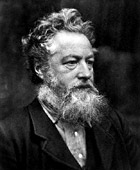William Morris was born in Walthamstow, Essex, on 24 March 1834. The son of a wealthy businessman, he enjoyed a comfortable childhood before going to Marlborough and Exeter College, Oxford.
He originally intended to take holy orders, but his reading of the social criticism of Carlyle, Kingsley and Ruskin led him to reconsider the Church and devote his life to art.
After leaving Oxford, Morris was briefly articled to G. E. Street, the Gothic Revival architect, but he soon left, having determined to become a painter. His admiration for the Pre-Raphaelites led him to be introduced to Dante Gabriel Rossetti whose influence can be seen on Morris's only surviving painting La Belle Iseult.
Arts and Crafts
In the 1860s Morris decided that his creative future lay in the field of the decorative arts. His career as a designer began when he decorated the Red House, Bexleyheath, which had been built for him by Philip Webb.
The success of this venture led to the formation of Morris, Marshall, Faulkner & Co. in 1861. The 'Firm' (later renamed Morris & Co) was particularly well-known for its stained glass, examples of which can be seen in churches throughout Britain. Morris produced some 150 designs which are often characterised by their delightful foliage patterns.
Among his many other works were Icelandic and classical translations, Sigurd the Volsung, The Pilgrims of Hope, and a series of prose romances which included A Dream of John Ball, News from Nowhere, and The Well at the World's End.
Politics
Morris entered national politics in 1876 as treasurer of the Eastern Question Association. This was a post he was to occupy in two further radical organisations: the National Liberal League and the Radical Union.
He soon became disillusioned with the Liberals and in 1883 joined the socialist Democratic Federation. After disagreements with the Federation's leader, H M. Hyndman, he formed the Socialist League, and later the Hammersmith Socialist Society.
During the 1880s he was probably the most active propagandist for the socialist cause, giving hundreds of lectures and speeches throughout the country.
The Kelmscott Press
In 1890 Morris founded the Kelmscott Press in premises near his last home at Kelmscott House in Hammersmith (now the headquarters of the William Morris Society). Morris designed three typefaces for the Press: Golden, Chaucer, and Troy. These were inspired respectively by fifteenth-century Italian and German typography. In all, sixty-six volumes were printed by the Kelmscott Press, the most impressive of which was its magnificent edition of Chaucer which was published in 1896. Morris died at Kelmscott House on 3 October 1896.
Biography by:
http://www.morrissociety.org/ |






